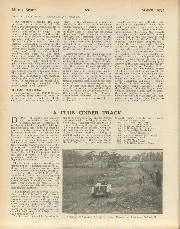
A CLUB CINDER TRACK
A CLUB CINDER TRACK DESPITE all possible combinations and permutations, there are only a limited number of competitions which may be held on the public highways, and apart from this,…
Air v. Water-Cooling.
Iread the remarks of your correspondent, ” Pro-Air,” with interest, but I do not agree with his views that air-cooled engines for racing cars would be an advance on the more usual type.
In pointing to the air-cooled a.ero engine as an example of what can be done with this method of cooling, he overlooks two vital facts. In the first place, the average aeroplane power unit turns over at a meagre 1,800 to 2,000 r.p.m. Secondly, it is treated to a constant stream of cooling air of about 80 m.p.h. velocity. it is, therefore, working under fairly favourable conditions.
The .modern racing car engine, on the other hand, as we all know, is kept busy at speeds ranging from 3,000 to 6,000 r.p.m. for long periods. Would it stick it if it was cooled by air ? Obviously not unless a blower were incorporated, and then there would be further complication. And what about the Schneider Trophy machines ? They were water-cooled.
G. D. Purley.